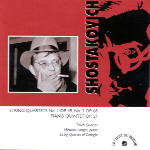Dmitri Shostakovich did not start writing his string quartets until he was 32 and had climbed out from under Stalin’s reprobation with the success in 1937 of the Fifth Symphony. We now know that when taken altogether Shostakovich’s 15 string quartets stand as remarkable documents of a private nature wherein the composer was able to explore ideas common to serialism and atonality without drawing undue attention from anyone in the cultural ministry. We also know that Shostakovich’s first and second quartets were written at a time when the composer had just concluded a major study of Beethoven’s symphonies and the quartets of Haydn. The early quartets (and the one piano quintet) show it. The First Quartet definitely has elements of Haydn’s execution and structure, but Shostakovich adds some of his own baroque playfulness–an aspect that will not appear in any of his subsequent works in the genre. Also missing in the quartets to come will be the folksong character found in the first two string quartets and the Piano Quintet in G minor. The performances of all three works are quite good, the two quartets overcoming potential live-recording distractions. Yes, a minor cough or two can be heard, but the miking of the players is judiciously focused and this allows for a stunning depth of recorded sound. And you won’t notice the segue from the last movement of the First String Quartet to the studio sound of the Piano Quintet. Live recordings tend to be “quickie” money-makers for some record companies, but live recordings also can capture tight, clean, and exciting performances, as they do here. Strongly recommended.
































